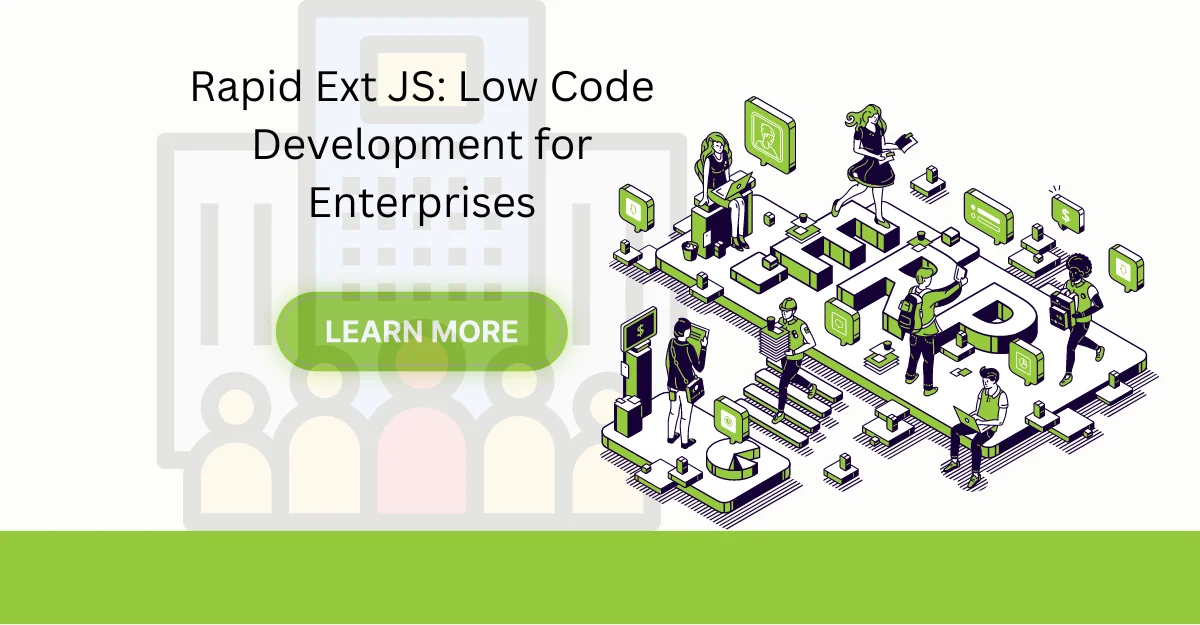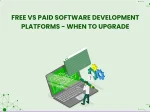Low Code Development Made Easy with Rapid Ext JS for Enterprises
Have you ever wondered how some companies roll out apps so quickly? In today’s fast-moving tech world, speed really matters. That’s where low code development comes in – it’s changing how businesses build software. Tools like Rapid Ext JS make life a lot easier for developers. Rapid Ext JS empowers developers to build powerful, low code React data grid applications, offering drag-and-drop components, live previews, and enterprise-ready performance without writing extensive code.
In this guide, we’ll break down what it really means & why it’s such a game-changer. You’ll get to know its key benefits, standout features, and how it’s a leading low-code tool for JavaScript – compared to the traditional Ext JS approach. This guide also compares low code vs rapid application development, showing how tools like Rapid Ext JS combine visual low-code simplicity with RAD speed for faster, scalable app delivery.

We’ll also share why platforms are a smart choice for businesses, how Rapid Ext JS helps speed up the process, and highlight some of the top low-code platforms to check out. Plus, we’ll explain what a low-code editor is & how it can make development even simpler.
Let’s dive in to see how you can take your app-building to the next level.
Understanding Low Code Development
Low code development lets you build apps faster without writing tons of code. Instead of typing everything out, you can drag & drop various sections into the places you want using visual tools. Individuals without any coding experience may now build programs more easily.
For example, say you need a system to manage customers. Usually, you’d have to write a lot of code to build it from scratch. But with low code, you just pick ready-made pieces and drag them into place. You can add customer forms, databases, and other features with very little coding needed.
One of the best low code development platforms is Power Apps from Microsoft. Its easy-to-use dragging & dropping interface allows you to create unique applications for business purposes. Connecting your app to programs like SharePoint or Excel is simple. Another great example is Salesforce Lightning, which helps companies create apps to manage customer relationships more efficiently. Rapid Ext JS is a leading low code JavaScript UI library that lets developers build modern, responsive apps quickly without writing tons of code.
Low code enterprises enable organizations to accelerate digital transformation by empowering teams to build scalable, secure, and customized applications without relying heavily on manual coding.
Enterprise RAD tools like Rapid Ext JS empower organizations to accelerate application delivery, streamline workflows, and maintain high-quality standards across complex, large-scale projects. It helps businesses save time and money. It also makes it possible for people from different backgrounds – not just expert developers to contribute to rapid web app development. This is especially useful for companies that need to move fast and keep up with constant changes.
Also Read: Enterprise Software Development Process: 6-Step Approach for Success.
Benefits and Key Features of Low-Code Development for Modern Enterprises
Low code development offers many benefits for businesses. Here are the main advantages and features with real-life examples:
Benefits
A company needs a new tool to manage projects. Using traditional coding might take months to develop. With low code, it can be done in weeks using ready-made parts and templates.
- Low code platforms reduce the need for many developers and shorten the development time, which saves money.
- A marketing manager with little coding knowledge can create a custom analytics dashboard. This allows more team members to contribute to app development.
- A retail company can quickly update its sales app to meet new market demands without a complete redevelopment. Low code application development makes it easy to modify and improve apps.
- Business and IT teams can work together better. Business users can create prototypes, and IT can refine and deploy them, ensuring the final product meets business needs.
Key Features
- Users can drag a customer feedback form onto their design and customize it without writing any code.
- Users can start with a template with features like contact management and reporting to create a CRM system.
- A logistics company can integrate its low code app with existing systems like ERP and CRM, ensuring smooth data flow across the business.
- A startup can start with a simple app and expand it as its business grows. Furthermore, adding new features and supporting more users.
- Financial institutions can use low-code platforms that meet industry standards. Hence ensuring their apps are secure and comply with regulations.
Low code development isn’t a trend – it’s a smart business strategy for staying ahead in today’s rapidly changing tech world. You can be a startup creating your first application or a large company updating internal software. This platform offers you the ability to respond quickly without hiring a team of professionals. They’re designed to simplify the process further & make it more collaborative so that anyone with an idea can bring it to making it a reality.
What Makes Rapid Ext JS a Game-Changing Low-Code Tool for JavaScript Developers?
Rapid Ext JS is a low-code tool that makes building Ext JS applications faster and easier. It works as an extension for Visual Studio Code, a popular code editor. Rapid Ext JS supports over 140 Ext JS components. Besides, it enables quick and efficient app creation with features such as:
- Live previews
- Customizable themes
- Various view modes.
The extension comes with a handy toolbox, a clear view of how components are organized, and a screen resolution selector. These features help developers design rapid web application development framework that work well on different devices and are strong in performance.
Its user-friendly interface lets developers build new Ext JS apps or update existing ones without hassle. It can automatically create basic code and link events to different parts of the app. With Rapid Ext JS, any changes in design or code happen instantly, so both views stay up to date in real-time. Below are some of the standout key features that make Rapid Ext JS a valuable choice for building modern web apps:
- Code view, design view, and split view to see both code and design simultaneously.
- It allows developers to zoom in up to 500% and zoom out to 25% for detailed component inspection.
- The toolbox can be positioned to the right, left, or below the design view for convenience.
- Includes commands to restart or stopwatches, run builds, and build dynamic packages.
- Multiple themes like light, solarized light, dark, and abyss to suit different developer preferences.
- Provides a wide range of user experience components like grids, buttons, panels, data views, carousels, menus & sliders.
- Helps in previewing how components will look on different devices by choosing from 15 different screen resolutions or setting custom dimensions.
- Offers standard and premium packages for download and installation, with a one-click installer for ease of use.
- Displays the tree structure of components from parent to child, aiding in better organization and navigation.
- Allows for the easy creation of panels, containers, tab panels, or grid views with auto-generated folder structures and associated files.
Rapid Ext JS is trusted by many Fortune 100 companies. It provides a strong solution for creating data-intensive HTML5 applications up to 500 times faster. It empowers developers to build sophisticated web apps efficiently, maintaining high code quality & performance. Are you planning to start building apps with Ext JS? Watch here.
Rapid Ext JS Compared to Traditional Ext JS Development
When choosing between Rapid Ext JS and traditional Ext JS, it helps to understand their key differences. The table below highlights how each approach handles speed, design, learning curve & tools.
| Aspect | Rapid Ext JS | Traditional Ext JS |
|---|---|---|
| Speed and Efficiency | Fast development with drag-and-drop. Instant live previews of changes. Reduces coding time significantly. | Requires detailed manual coding. No live previews; you need to run the app to see changes. Longer development time. |
| User Interface Design | Visual design with easy drag-and-drop. Customizable themes and responsive design tools. | Design through coding. More effort needed for customization and responsiveness. |
| Learning Curve | Easy for beginners with its visual interface. Less coding knowledge required initially. | Steeper learning curve, involves more coding. Suited for experienced developers. |
| Development Tools | Integrated with Visual Studio Code. Offers zooming, screen resolution selection, and component hierarchy views. | Uses standard code editors. Manual event binding and code generation. |
Understanding these low code vs traditional development differences can help you pick the right tool based on your team’s skills & project needs. Rapid Ext JS is ideal for quick development and those new to coding, while traditional Ext JS suits developers who prefer full control through manual coding.
Rapid Ext JS Explained in 59 Seconds⚡️| The Powerful Low-Code Editor
How Rapid Ext JS’s Low-Code Editor Boosts App Development Speed
Rapid Ext JS is a low-code platform designed to make building web rapid application development faster and simpler. It offers an easy drag-and-drop interface inside Visual Studio Code, allowing developers to quickly design applications without writing a lot of code.
With over 140 ready-to-use components, you can build your app’s layout and features while seeing live previews of your work. Customizable themes make it easy to create polished, professional designs.
Because changes show up instantly, developers spend less time on manual coding and debugging. This helps both beginners and experienced developers build apps more efficiently.
Also Read: Low Code Development Made Easy with Rapid Ext JS for Enterprises
Top 10 Low-Code Platforms to Build Apps
1. Rapid Ext JS
This makes low code development software easy by allowing you to drag & drop features directly within Visual Studio Code. It has a wide range of ready-to-use elements, so you won’t have to create everything from the start. You can see changes immediately with live previews & customize the appearance with various themes. This makes it an ideal option for anyone looking to create software in no time without dealing with complex coding.
2. Mendix
It is a widely used low code application development platform that is specifically built to facilitate Agile products, allowing teams to easily collaborate & create apps quickly. It provides a graphical environment wherein you can model, test, and use applications without excessive coding. This is perfect for companies that wish to rapidly evolve and continually enhance their software.
3. OutSystems
This is a low code development platform with lots of flexibility that allows you to develop web, mobile & desktop tools in one place. It uses smart AI to provide an extensive library of reusable components, which helps speed up the development process. This makes it a suitable option for those who want to develop quality apps quickly without starting from scratch.
4. Microsoft Power Apps
It integrates well with other Microsoft solutions such as Excel, SharePoint & Teams. It allows you to create business solutions quickly through an easy-to-use visual interface. You can easily incorporate artificial intelligence features into your apps without writing a lot of code. This is perfect for all firms already invested in these rapid application development tools who need to create powerful apps quickly.
5. Appian
This is excellent for companies that need to automate processes & manage cases effectively. It combines low-code development with strong automation capabilities, allowing it to be simple to create applications that automate processes & enhance productivity. This platform enables teams to develop solutions that perform complex tasks in no time without the requirement for a lot of coding.
6. Kissflow
It is designed to enable teams to work smarter by streamlining workflow creation and management. It’s easy to use, so technical & non-technical individuals can create software with ease. This makes it a perfect option for any business that wants to increase productivity in a hassle-free manner.
7. Zoho Creator
It is popular for being simple & user-friendly. This is especially good for businesses that want to connect their software easily with CRM systems. With its easy visual tools, anyone can quickly build custom apps without needing advanced coding skills.
8. Quickbase
This is for individuals who are not technologists. It simplifies creating tailored business applications using information from databases and spreadsheets. It is also geared towards workflow automation, enabling teams to work smarter & faster without complex coding.
9. Salesforce Lightning
This is designed specifically for the users of the Salesforce platform. You can design customer relationship management apps with ease using simple drag-and-drop components. This enables companies to design effective rapid web application development tools to manage their customers without having to write deep code.
10. ServiceNow
It is a powerful platform to automate workflows & support quick data-driven applications quickly. It has ample ready-to-use actions and templates, which allows businesses to quickly develop custom apps without having to start from scratch. This saves time and increases productivity.
Conclusion
Low code app development is changing how companies develop applications. It is making it quicker, easier & less expensive than the traditional coding. Rapid Ext JS and similar products, with their drag-and-drop functionality and live preview, enable even those without deep coding experience to develop excellent apps.
Platforms like Rapid Ext JS, Mendix & OutSystems enable teams to collaborate more effectively, make changes to software with ease, and integrate flawlessly with other systems. With the speed-up of business, using this is an intelligent way of keeping up, staying flexible, and growing.
FAQs
What is the best low code platform?
Some popular & reliable ones are Rapid Ext JS, Mendix, OutSystems & Microsoft Power Apps. The best choice depends on what you need – like how complex your application is, what tools you want to connect to & how easy the platform is for your team to use.
What do programmers think of low code development platforms?
They mostly like low-code because they speed up application building & let non-coders help. However, some worry they limit control for complex projects. Overall, it is seen as a helpful tool for faster, simpler development.
Which low code development platform provides a relational database?
Several offer built-in relational databases. For example, Mendix, OutSystems & Zoho Creator let you create and manage relational data easily within your app without needing extra setup.
How low code development is related to cloud computing?
It often runs on the cloud or connects easily to its services. This means you can build, host & update apps online without needing your own servers. This computing helps low-code tools offer fast deployment, easy collaboration, and access from anywhere.
What information is taken in a drag and drop file?
In drag-and-drop, the file usually contains details about the app’s layout, components used (like buttons & forms), their properties (like size & color), and how they connect or behave. This helps the platform recreate the application visually and generate the underlying code automatically.
Start using a low-code platform today to transform your app development process!

Every software project begins with a choice that reverberates through its entire lifecycle: which development…

Building software for regulated industries demands more than functional code. Healthcare organizations must protect patient…

The Ext JS Data Grid is widely regarded as one of the most feature‑rich and…









